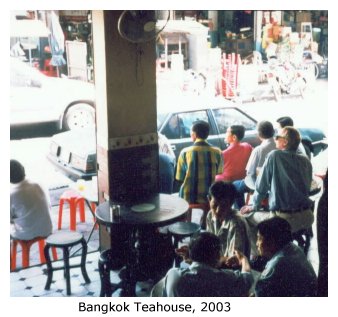

|
| weblog/wEssays | home | |
|
Can You Tell What I Am? Part I (June 2005)  It took us some time to locate this old teahouse in the narrow winding alleys of Bangkok's Chinatown.
A single reference in a long-outdated guidebook mentioned the old teahouses on this street--though alley better
describes its width and abundant foot and cart traffic--and with some modest perseverence we located what
may well be the last old teahouse in the entire megalopolis of Bangkok.
It took us some time to locate this old teahouse in the narrow winding alleys of Bangkok's Chinatown.
A single reference in a long-outdated guidebook mentioned the old teahouses on this street--though alley better
describes its width and abundant foot and cart traffic--and with some modest perseverence we located what
may well be the last old teahouse in the entire megalopolis of Bangkok.
I am visible in the far right, the lone farang, gaijin, round-eye, big nose, Anglo-Saxon, Caucasian, haole, etc. in the joint--and indeed, on the street. While there is much to be said of interest about this comfortably worn establishment--its limited menu of snacks, iced or hot tea or coffee, its gregarious waitresses, its unparalleled view of street life meandering by--what struck me at the time was my complete Otherness: a tall, slim (rare for a middle-aged Westerner nowadays, alas) very pale male dressed in a terribly formal long-sleeved shirt (to keep from getting horrendously sunburned) and a foolish floppy hat. To be Other is to be expected, of course, in a distant land where people don't look like you. But the edges are more blurred than you might expect. By which I mean: my Asian-American companion easily passed as Thai. In China, she easily passed for Chinese. In Japan, her actual nation of heritage, she passed occasionally for Japanese, but not always, due to the robustly tanned result of her Hawaiian upbringing (anathema to most refined Japanese and Chinese ladies). In Oakland Chinatown, she passes for Vietnamese or Chinese. In Thailand, people addressed her in Thai; in China, they spoke first in Mandarin. Clothing, of course, can give you away, but jeans and a T-shirt pass just about anywhere as "local" (and we have no interest in visiting places where it doesn't). In dressed-up Japan, her informal wear gave her away as foreign. But elsewhere, in countries where peasant faces are still darkened by the sun and not everyone has money to clothe themselves in expensive finery, she is routinely seen as local. You'd think a haole could experience the same anonymity in Europe, but Americans seem, even to my unpractised eye, to stick out: they talk loudly in American English ("like, I am so over X"), they're dressed like slobs or college kids (whichever sounds better to you), the young ones sport idiotic tattoos (um, do you know those Chinese characters mean "I suck, kick me"?), they're overweight, and they wear--gasp--sandals instead of proper shoes. Thus I am inordinately proud to report that I was asked for directions no less than five times in my recent walks around Paris (my "Paris Transect"). Yes, I have 12.5% French blood, but I doubt it overrides all the Scots and English; yes, I wore leather shoes (it was, after all, late October) and a proper shirt and trousers; and no, I do not speak more than strained schoolboy French. But still, something about me caused French strangers--oui, every one was French--to buttonhole me and ask for directions. This may well say more about the convoluted nature of Parisian streets than about my extraordinary "Frenchness," but I took it as a enormous compliment. Pardon moi, je ne sais pas rolled rather expertly off my tongue by the last hours of my walkabout. * * * copyright © 2005 Charles Hugh Smith. All rights reserved in all media. I would be honored if you linked this wEssay to your site, or printed a copy for your own use. * * * |
||
| weblog/wEssays | home |